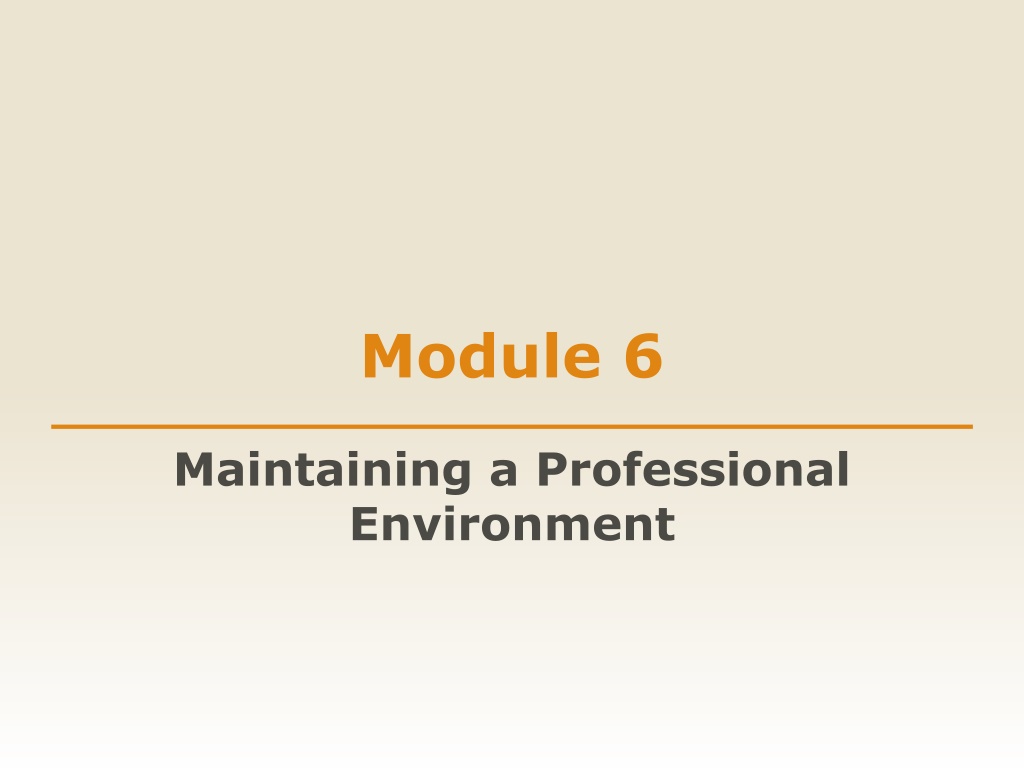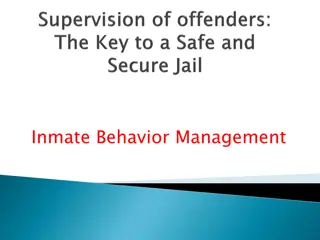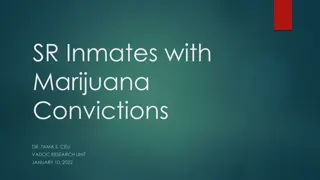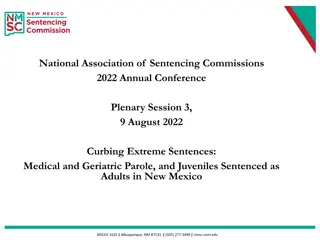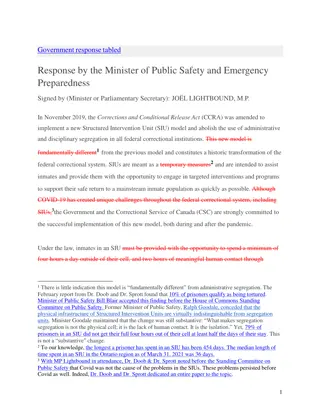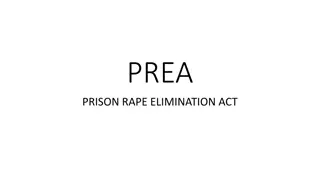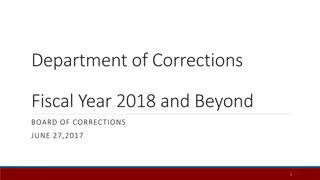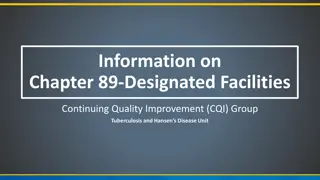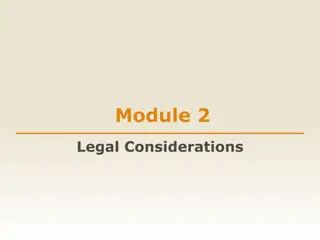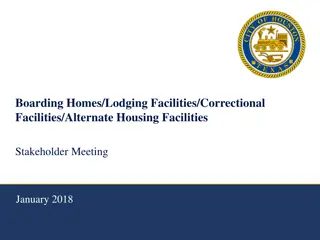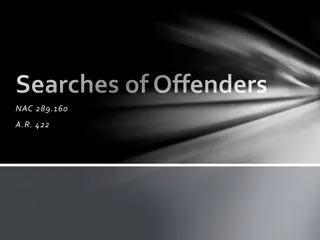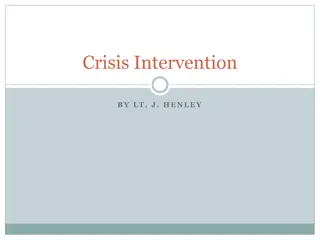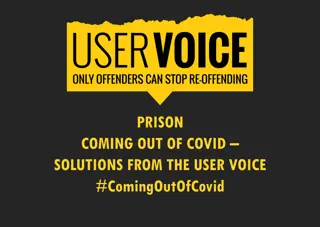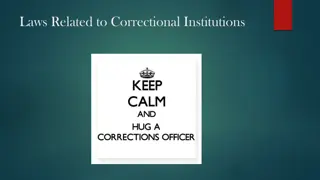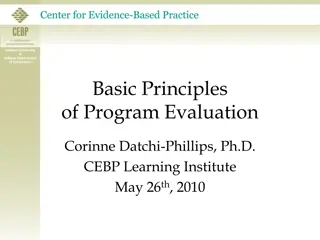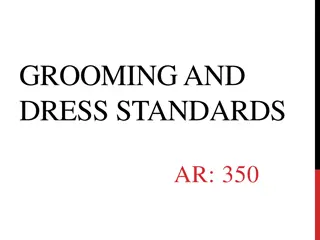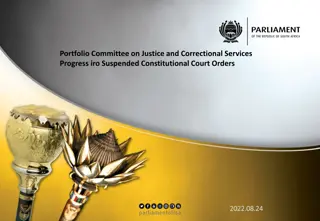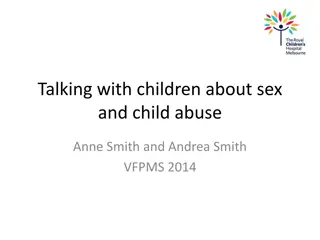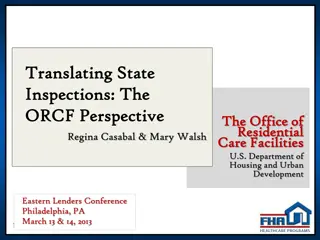Understanding and Respecting LGBTI Inmates in Correctional Facilities
This module focuses on maintaining a professional environment by providing training on respectful communication with LGBTI inmates, conducting searches in a professional and least intrusive manner, and effective communication strategies. It also covers definitions of sexual orientation, gender identity, gender expression, and related terms, emphasizing the importance of preventing sexual harassment and discrimination against LGBTI individuals in corrections facilities.
- LGBTI inmates
- Professional environment
- Respectful communication
- Employee training
- Sexual orientation
Download Presentation

Please find below an Image/Link to download the presentation.
The content on the website is provided AS IS for your information and personal use only. It may not be sold, licensed, or shared on other websites without obtaining consent from the author. Download presentation by click this link. If you encounter any issues during the download, it is possible that the publisher has removed the file from their server.
E N D
Presentation Transcript
Module 6 Maintaining a Professional Environment
Respectful Communication with Lesbian, Gay Bisexual, Transgender, and Intersex (LGBTI) Inmates
Employee Training According to the PREA standards, staff must receive training in: How to conduct cross-gender pat-down searches, and searches of transgender and intersex inmates, in a professional and respectful manner, and in the least intrusive manner possible, consistent with security needs How to communicate effectively and professionally with inmates, including those who are lesbian, gay, bisexual, transgender, intersex, and gender nonconforming
Quiz The terms gay, lesbian, and bisexual refer to: A. Sexual behavior B. Sexual orientation C. Gender identity D. Dating compatibility
Definitions Sexual Orientation A person s physical and romantic attractions to other people. Common terms to refer to sexual orientation include: heterosexual, lesbian, gay, and bisexual.
Quiz The term transgender refers to: A. Sexual orientation B. Feminine demeanor C. Gender identity D. Self expression
Definitions Gender Identity The psychological sense of being male, female, or in-between.
Definitions Gender Expression: the way a person expresses gender identity (e.g. mannerisms, hair, dress) Gender Nonconforming/Gender-variant: a person whose appearance or manner does not conform to traditional societal gender expectations Transgender Person: someone whose gender identity or expression is different from their gender assigned at birth Intersex: a person whose sexual or reproductive anatomy or chromosomal pattern does not seem to fit typical definitions of male or female
Sexual Harassment of LGBTI Inmates Sexual harassment and discrimination against LGBTI inmates are pervasive in corrections facilities. Sexual harassment can include derogatory or demeaning comments about someone's actual or perceived sexual orientation, gender identity, and/or gender expression. Sexual harassment may be a precursor to more violent forms of sexual violence.
BJS Research: Sexual Abuse of LGBT Inmates Prisoners who identify as lesbian, gay, bisexual, or other are more than 10 times more likely to be sexually abused by another inmate than heterosexual prisoners. Bryson is a gay inmate who was repeatedly gang-raped in a state prison. He contracted HIV as a result of the abuse, and later died due to complications related to AIDS. Source: Bureau of Justice Statistics, Sexual Victimization In Prisons And Jails Reported By Inmates, 2011-12, May 2013.
BJS Research: Sexual Abuse of LGBT Inmates Source: Bureau of Justice Statistics, Sexual Victimization In Prisons And Jails Reported By Inmates, 2011-12, May 2013
PREA Standard 115.42 PREA standards require that agencies: Make individualized determinations about how to ensure the safety of each inmate Consider a transgender or intersex inmate s housing and programming needs on a case-by- case basis Review placement and programming assignments for transgender and intersex inmates at least twice a year
PREA Standard 115.42 PREA standards require that agencies: Take a transgender or intersex inmate s views regarding his or her own safety into account; Allow transgender and intersex inmates to shower separately; Refrain from placing LGBTI inmates in dedicated facilities, units, or wings solely on the basis of their gender identity or sexual orientation, unless otherwise required by law for the purpose of their own protection.
Relevant Policies [Insert relevant policies regarding the treatment of LGBTI prisoners, in accordance with the PREA standards.]
Professional Language Professional Sexual orientation Gender identity Unprofessional Sexual preference Alternative lifestyle Homo Dyke Queer Tranny Hermaphrodite Lesbian Gay Bisexual Transgender Intersex Them/they/he/she He/she, shemale, it
Working With LGBTI Inmates Realize that any inmates you work with might be LGBTI. Demonstrate respect and professionalism for all inmates. Reach out to anti-violence and LGBTI support organizations, as needed.
Maintaining a Professional Environment
Professional Boundaries A boundary is the limit of appropriate behaviors or interactions between a staff member and an inmate. Boundaries are defined by laws, policies, and professional codes of ethics, and protect the professional relationship.
What do you consider your Code of Ethics at work?
Codes of Conduct [Reference relevant professional codes of conduct and summarize agency policies on professionalism and appropriate staff boundaries. Examples include the AJA Code of Ethics for Jail Officers, fraternization policies, and other professional conduct policies.]
What staff behaviors would be considered unprofessional or inappropriate?
Examples of Unprofessional Conduct Using drugs or alcohol Bringing prohibited items to work Deviating from agency policies Picking fights with coworkers or inmates Gossiping about coworkers or inmates Flirting with inmates Falling asleep at work Calling coworkers or inmates derogatory names or terms Talking to inmates about personal issues Imposing arbitrary consequences or discipline
Why is maintaining professional boundaries so important in a jail?
Impact of Unprofessional Conduct Encourages sexual harassment and abuse Weakens respect for staff among coworkers and inmates Poses a threat to inmate, staff, and community safety Leads to population management problems, such as conflict among staff and inmates Exposes staff to potential legal liabilities Contributes to lack of morale among staff and inmates
Boundary Maintenance The responsibility for setting and maintaining boundaries always belongs to you, not inmates. You and your coworkers must set and maintain clear limits. Review your performance with coworkers and supervisors regularly. Adapted from Nebraska Department of Correctional Service s training, Correctional Boundaries
Group Response Activity Discuss how you would you respond to the following statements made by an inmate: 1. Nice hair cut. 2. You do a better job than most of the staff. 3. I had a dream about you last night. 4. Do you have children? 5. Can I tell you something just between us? 6. Can you do me a favor? Adapted from Nebraska Department of Correctional Service s training, Correctional Boundaries.
Impact of Professional Conduct Encourages safety and zero tolerance for sexual abuse and sexual harassment Increases respect for staff among colleagues, the public, and inmates Promotes inmate, staff, and community safety Leads to greater harmony and strong jail management Protects staff from potential legal liabilities Contributes to morale among staff and inmates
Wrap-up and Discussion Questions [List other items to be completed, such as a post-training survey or evaluations. Be sure all staff sign out or otherwise indicate that they attended and understand the training.]
Instructor Information [List instructor contract information and where staff can get additional information related to the training.]
